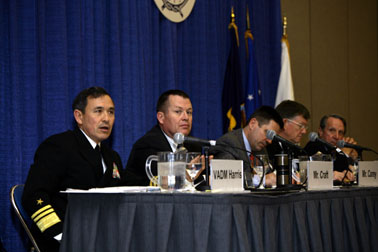 |
| Panelists discussing "What keeps you up at night?" include (l-r) Vice Adm. Harry B. Harris Jr., USN; James P. Craft; Robert J. Carey; Vice Adm. H. Denby Starling, USN; and panel moderator Vice Adm. Herbert A. Browne, USN (Ret.). |
No solution to the cyberspace threat seems imminent or even obvious, according to a panel asked "What keeps you up at night?" Cyberspace enemies can attack anywhere, and they don't need to expend any extraordinary resources to be effect in the infosphere.
Vice Adm. H. Denby Starling II, USN, commander, Naval Network Warfare Command, admitted that he does not have the visibility across the Navy's networks that most people would agree he needs. And, all an enemy needs is a laptop and access to a Starbuck's VPN to be a player in cyberwarfare.
The Navy today has a network operations model that is highly people-dependent, he added. Building new networks that are human labor intensive is a non-starter. Security must move away from people dependency as much as possible.
Acquisition is a headache, implied Robert J. Carey, Department of the Navy Chief Information Officer. Regulations and laws hinder development, and cycle times cannot keep pace with information technology.
Vice Adm. Harry B. Harris Jr., USN, deputy chief of naval operations for communications networks (N-6), echoed Carey's remarks. "We're fighting an information age war with industrial age acquisition," the admiral stated.
Carey surprised no one when he said that the Navy is moving too slowly into Web 2.0 technologies and capabilities. Most of the Navy's processes are digitized paper processes, and he emphasized that this must change. When the Navy fully enters the world of Web 2.0, it will free up resources that can be used to acquire other vital systems such as ships.
But none of these efforts will matter if attention is not paid to the supply chain, said James Craft, deputy director, C4/deputy chief information officer of the Marine Corps. Craft warned that if no one can trust foreign sources in the supply chain for weapons systems, then "everything we do is a wash."
Craft challenged industry to come up with the solutions for Navy IT challenges. Industry should develop open-source solutions and standards "to scratch its own itch," he said.




